 Funding Balcony Inspections and Repairs.
Funding Balcony Inspections and Repairs.
Inspections Required. Beginning January 1, 2020, condominium developments with three or more units per building must inspect elevated load-bearing structures supported substantially by wood. (Civ. Code § 5551(l).) The inspector must submit a report to the board providing the structures' physical condition and remaining useful life and associated waterproofing systems. The statute does not change who is responsible for maintaining, repairing, and replacing balconies or other elevated structures. It imposes inspection and repair obligations on HOAs as to balconies and/or elevated structures that associations are obligated to repair and replace.
Waterproofing Systems. Water intrusion into balconies, decks, and other elevated structures is the primary factor causing damage to the wood that supports those structures. It has led to the collapse of many structures around the nation, including the Berkeley balcony that killed six college students and seriously injured seven others. Water intrusion can quickly lead to dry rot and the loss of structural integrity, which is why waterproofing must be inspected.
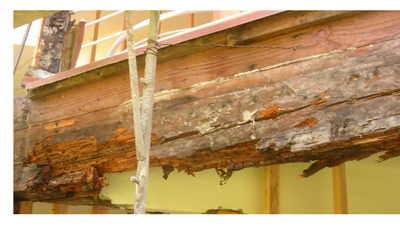 Dry Rot Defined. The term "dry rot" is a misnomer. Wood does not rot when it is dry. For decay to occur, moisture must be present for fungi to feed on wood. Like viruses and bacteria, fungal spores are microscopic and travel through the air. The spores act as seeds that grow when they land on moist wood products. When they plant themselves into wood, they feed on the wood's cellulose. Cellulose is what gives wood its strength. As the fungi consume cellulose, the wood weakens. Without moisture, fungi cannot grow; thus, the importance of keeping all waterproofing systems well-maintained. That is why the Davis-Stirling Act requires a thorough inspection of waterproofing components such as flashings, membranes, coatings, and sealants. (Civ. Code § 5551(a)(1).)
Dry Rot Defined. The term "dry rot" is a misnomer. Wood does not rot when it is dry. For decay to occur, moisture must be present for fungi to feed on wood. Like viruses and bacteria, fungal spores are microscopic and travel through the air. The spores act as seeds that grow when they land on moist wood products. When they plant themselves into wood, they feed on the wood's cellulose. Cellulose is what gives wood its strength. As the fungi consume cellulose, the wood weakens. Without moisture, fungi cannot grow; thus, the importance of keeping all waterproofing systems well-maintained. That is why the Davis-Stirling Act requires a thorough inspection of waterproofing components such as flashings, membranes, coatings, and sealants. (Civ. Code § 5551(a)(1).)
Maintenance and Repairs. Fungi (like termites) spread throughout a structure as they feed on wood. As a result, dry rot can be difficult to treat. To stop the destruction, all decayed wood and fungi must be removed. The longer it goes untreated, the weaker the wood becomes until it collapses without warning. See: Balcony Maintenance & Repairs. Also see Common Area Maintenance as well as Exclusive Use Maintenance.
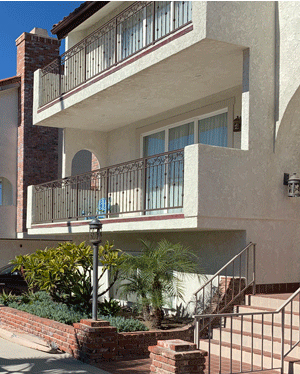 |
 |
| #1 Cantilevered Balconies |
#2 Balcony on Posts
|
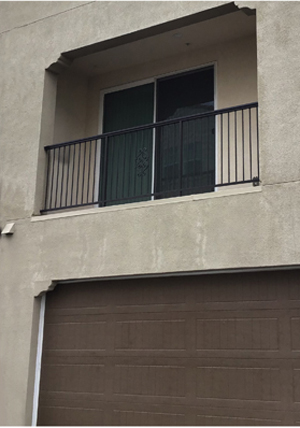 |
 |
#3 Balcony over Garage
|
#4 Balcony over Garage
|
 |
 |
#5 Stairs & Landings
|
#6 Elevated Walkways
|
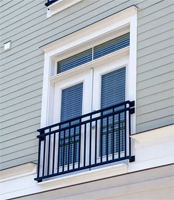 |
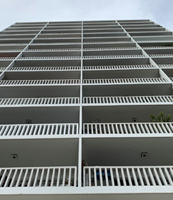 |
| #7 Juliette Balcony |
#8 Highrise Concrete Balconies |
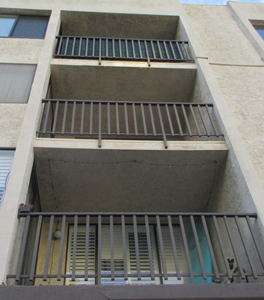 |
| #9 Balcony Flush with Building |
Exterior Elevated Elements Defined. Required inspections apply to load-bearing components and associated waterproofing systems. "Load-bearing" means (i) those components that extend beyond the exterior walls of the building to deliver structural loads to the building from decks, balconies, stairways, walkways, and their railings, (ii) that have a walking surface more than six feet above ground level, (iii) that are designed for human occupancy or use, and (iv) are supported in whole or in substantial part by wood or wood-based products. (Civ. Code § 5551(a)(3).)
Illustrations. On the right side of the screen are examples of different configurations of elevated structures needing inspection.
- Cantilevered balconies constructed of wood must be inspected.
- Balconies supported by wood posts require inspection.
- Balconies supported by the main structure do not require inspection since they cannot collapse. Balcony railings, however, can give way and should be inspected and included in the association's reserve study.
- Balconies partly supported by the structure and partly cantilevered require inspection.
- Exterior stairs and landings attached to wood require inspection.
- Elevated walkways supported by wood structures must be inspected.
- Juliette balconies are decorative and do not meet inspection requirements. However, if they are attached to wood, and a person can lean against them, they should be inspected.
- Balconies made entirely of concrete and steel do not require inspection.
- Balconies flush with the building.
NOTE: Elevated structures that do not require inspection under Civil Code § 5551 still require a diligent visual inspection for purposes of an association's 3-year cycle of inspections for their reserve study. This includes concrete balconies.
Townhouse Balconies. A townhouse is a form of construction, not a form of ownership. A townhouse can be defined as a condominium or a separate interest in a planned development. If the townhouse is a condominium, responsibility for balconies will depend on how a condominium unit is defined. If the unit's boundaries are the unfinished surfaces of the interior walls, ceilings, and floors, the townhouse structure is owned in common by the membership. That makes the association responsible for the repair and replacement of the structure unless the CC&Rs clearly state otherwise. (Civ. Code § 4775.) If a unit's boundaries are defined as extending to the exterior surfaces of the townhouse, the structure becomes part of the unit and is the responsibility of the homeowner unless the governing documents state otherwise. NOTE: Boards should have their documents reviewed by legal counsel.
If townhouses are defined as a planned development, homeowners own the structure and the lot upon which it was built. That means homeowners are responsible for their own balconies. The balcony bill does not apply to planned developments, only to condominiums.
Balcony Railings Inspections. Balcony railings must also be inspected to see if they are attached to wood or wood products. Even if the balcony does not extend beyond the exterior walls, the railings could fail, causing serious injuries or death. See photos #3, #7 and #9 as examples where railings should be inspected even if the "balconies" do not.
Picture #9. This picture is of particular interest because the balconies do not extend out from the building. Even though they are flush with the building, each is more than six feet above the one below it. Also, the railings are attached to wood products and could fail, sending someone falling to their death. Arguably, they might not fall under the statute; even so, they should be inspected.
Out of Code Railings. If the railings themselves no longer meet code, i.e., the spacing between bars is more than 4 inches and the railing height is less than 42 inches, the railings must be brought up to code whenever they are being replaced. If the the supporting wood is dry rotted, which requires replacement of the railings, they need to be brought up to code. If balconies do not require any repairs, the railings are normally grandfathered. Even so, an association's insurance carrier may require railings on elevated structures (balconies, decks, and walkways), and fences around pools be brought up to code.
Stair Inspections. See information about Stair Inspections and Maintenance.
Deadline for Inspections. Associations must complete their first inspection before January 1, 2025. Thereafter, elevated structures must be inspected at least once every nine years. (Civ. Code § 5551(b)(1).)
Architect/Engineer and Reserve Analyst. The inspections must be conducted by a licensed structural engineer or architect. (Civ. Code § 5551(b)(1).) The inspector must inspect a sufficient number of units to provide 95 percent confidence that the results from the sample are reflective of the whole, with a margin of error of no greater than plus or minus 5 percent. (Civ. Code § 5551(a)(4).) The association's reserve study professional should be notified when the inspection occurs since the result could impact the cost allocations for particular line items in the study. Below is a list of inspection companies readers sent to us. Boards should have legal counsel review any proposed contracts.
Borescopes. Inspectors are allowed to use the least intrusive method necessary to examine load-bearing components, including visual observation in conjunction with moisture meters, borescopes, and infrared technology. (Civ. Code § 5551(a)(5).) The advantage of a borescope is that only small holes are drilled into the stucco, which are easily patched. However, it is sometimes difficult for the scope to see signs of water infiltration and deterioration of the framing. Often, the better approach is to open the underside of balconies so an inspector can easily see the structural elements. Some inspectors use both inspection methods, depending on the particular project and the condition of the structures.
Inspection Costs. To achieve the 95% confidence level required by the bill will be expensive. It is estimated that most associations should expect costs in the range of $5,000 to $20,000. The total cost will depend on the number of elevated structures inspected to achieve the high confidence level required by the bill.
Using Reserves. Because inspections are directly related to reserves needed to repair elevated structures and because the definition of "replacement cost" includes related expenses, inspection costs can be included in an association's reserve budget. Using reserves for such purposes would not be deemed a borrowing.
Inspector's Report. The inspector must submit a report to the board of directors specifying the current physical condition and remaining useful life of the load-bearing components and associated waterproofing systems and whether they are an immediate threat to the health and safety of residents. The report must also include recommendations for any necessary repairs. (Civ. Code § 5551(e).) The report must be kept by the association for at least two inspection cycles (18 years). (Civ. Code § 5551(i).)
Immediate Threat to Safety. If the inspector finds that the exterior elevated element poses an immediate threat to the safety of the occupants, the inspector must submit the report to the board immediately and to the local code enforcement agency within 15 days of completion of the report. The association must take preventive measures immediately upon receiving the report, including preventing occupant access to the exterior elevated element until repairs have been inspected and approved by the local enforcement agency. (Civ. Code § 5551(g).) Local enforcement has the ability to force immediate repairs, even if that requires an emergency special assessment.
Owner Damage. See Liability for Balcony Damage.
Contracting for Inspections and Repairs. Contracts prepared by vendors can sometimes be skewed to protect the vendor. This is normal but not particularly beneficial to the association. Before signing any contracts, boards should make sure legal counsel reviews them.
Inspection Companies. Below is a list of companies that perform inspections of elevated structures. The information was sent to us by readers of our newsletter and should not be construed as our endorsement of the performance of any of the companies listed below. Before hiring a company, boards must perform their due diligence and make sure the company is licensed and insured. In addition, boards should have legal counsel review all contracts before signing them.
A7 Group, Inc.
700 2nd St, Unit H
Encinitas, CA 92024
(760) 945-3700
Adam Rohrbaugh
[email protected]
www.a7architect.com |
A.D. Magellan
432 Vista Village Dr
Vista, CA 92083
(877) 899-5990
Felicia Baker
[email protected]
www.admagellan.com
|
AWS Consultants
2030 E 4th St, #208D
Santa Ana, CA 92705
(888) 245-6675
Carl Brown
[email protected]
www.awsconsultants.com |
Axis Consultants
2544 Barrington Ct
Hayward, CA 94545
(415) 846-2574
Katherine Kim
[email protected]
www.axisconsults.com
|
|
B2R Consulting Group
1740 W. Katella Ave, #L
Orange, CA 92867
(714) 744-6100
Any Bradvic
[email protected]
www.b2rconsultinggroup.com
|
Bergeman Const. Mgmt
11099 La Cienega Blvd, #175
Los Angeles, CA 90045
Randy Beery
(619) 599-6216
[email protected]
www.bergemangroup.com |
CL Sigler & Assoc.
521 Charcot Ave, #203
San Jose, CA 95131
74820 Borrego Dr.
Palm Desert 92260
[email protected]
www.siglercm.com
|
Design Build Associates
5655 Lindero Cyn Rd, #321
Westlake Village, CA 91362
(818) 889-0402
Dennis Brooks
[email protected]
www.dbuild.com |
Focused Inspection Group
1999 S. Bascom Ave, #700
Campbell 95008
333 City Blvd West, #1700
Orange, CA 92868
[email protected]
www.focusedinspections.com |
Leys Waterproofing
PO Box 14438
San Luis Obispo CA 93406
(805) 801-2380
William Leys
[email protected]
WLeyswaterproofingconsultants.com |
McCormick-JWC
926 S. Andreasen Dr, #108
Escondido, CA 92029
(760) 727-2494
Jon Wayne
[email protected]
www.mcc-jwc.com
|
Pacific InterWest
1600 South Main St, #380
Walnut Creek, CA 94596
Marlene Stewart
(925) 939-5500
[email protected]
www.pacificinterwest.com |
Rupert Constr. Services
9114 Adams Ave, #340
Huntington Beach, CA 92646
(714) 904-2885
Devin Dial
[email protected]
www.rupertservices.com |
SoCal Structural
18000 Studebaker Rd.
Cerritos, CA 90703, Suite 700
213-293-6647
Jeremy Livermore, SE, PE
[email protected]
www.socalstructural.com
|
SKS Construction
15134 Frair St.
Van Nuys, CA 91411
(818) 855-1181
Sam Shaolian
[email protected]
www.sksconstruction.com |
Southern Cross Consultants
4045 Hancock St, #240
San Diego, CA 92110
(858) 395-8657
Matthew Boomhower, AIA
[email protected]
www.SouthernCrossPC.com |
Sullivan Construction Mgmt
P.O. Box 2387
Alpine, CA 91903-2387
(619) 722-7580
Pat Sullivan
[email protected]
www.sullivancm.com |
Van Sande Consultants
2920 De la Vina Street
Santa Barbara 93105
(805) 963-6901
Carolle Van Sande, CSM
[email protected]
www.vansandestructural.com |
CM Squared, Inc.
39899 Balentine Dr, #200
Newark, CA 94560
(619) 609-1610
Annie Wyland
[email protected]
www.gocm2.com
|
SMR
1495 Pacific Highway, #400
San Diego, CA 92101
(619) 294-6600
Nydia Parra
[email protected]
www.smr-eng.com
|
Acknowledgment. Thank you to Dennis Brooks of Design Build Associates for photos of balconies and to Bill Leys of Leys Waterproofing Consultants for his photo of dry rot in a balcony beam.
Stock Coops & Community Apartments. Stock cooperatives and community apartments are both forms of common interest developments governed by the Davis-Stirling Act. Civil Code § 5551(l) states that inspections of elevated wooden structures apply to multi-family structures with three or more units. This would seem to apply to stock co-ops and community apartment projects. However, the statute also states, "At least once every nine years, the board of an association of a condominium project shall cause a reasonably competent and diligent visual inspection to be conducted..." (Civ. Code § 5551(b)(1).)
That language seems to let these two forms of common interest developments off the hook even though they own and are responsible for maintaining and repairing balconies and other elevated wooden structures. The statute's clear intent is to increase the safety of residents in associations. Accordingly, stock co-ops and community apartment projects should voluntarily follow the statute's requirements to inspect and repair all elevated wooden structures. Doing so protects residents and minimizes any potential for lawsuits.
Recommendation. Because of the anomaly in the statute, stock cooperatives, and community apartment projects with multi-family structures with three or more units should get an opinion from legal counsel on how best to proceed. Clearly, the safer course of action is to inspect and repair elevated structures. Doing so protects residents and minimizes any potential for litigation and judgments against the association.
ASSISTANCE: Associations needing legal assistance can contact us. To stay current with issues affecting community associations, subscribe to the Davis-Stirling Newsletter.